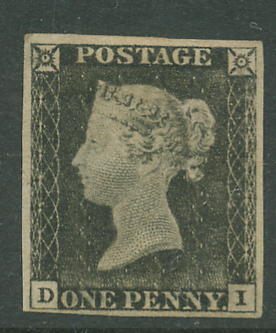
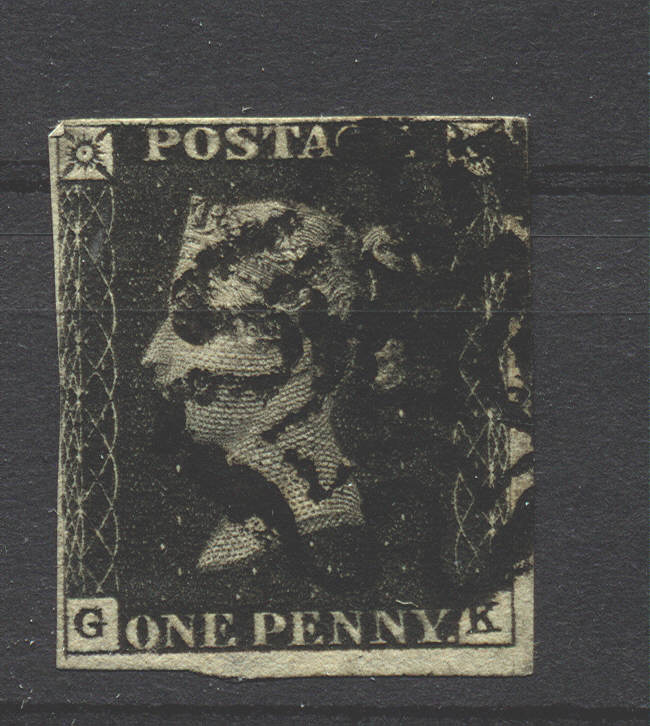
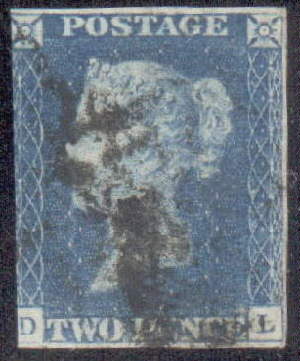
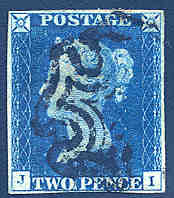
Return To Catalogue - Great Britain Overview
Note: on my website many of the
pictures can not be seen! They are of course present in the cd's;
contact me if you want to purchase them: evert@klaseboer.com.
1 p black (Penny Black) 2 p blue
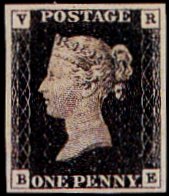
(Non issued official stamp, 'VR' in the upper corners)
The 1 p is called 'Penny Black' it is the first stamp ever issued in the world. A 1 p black with the letters 'VR' in the upper corners was prepared as official stamp, but was never issued. These stamps have watermark 'Small Crown':
There are letters printed in the lower corners of the stamp. According to their position on a sheet of stamps, thereby creating 240 different stamps. Thus the first upper left stamp has the letters 'AA', the next one 'AB' until 'AL' for the most upper right stamp. The second row has 'BA', 'BB', BC' to 'BL'. The bottom row has 'TA' at the left up to 'TL' for the bottom right hand corner stamp.
Value of the stamps |
|||
vc = very common c = common * = not so common ** = uncommon |
*** = very uncommon R = rare RR = very rare RRR = extremely rare |
||
| Value | Unused | Used | Remarks |
| 1 p | RRR | R | |
| 2 p | RRR | RR | |
| 1 p VR in upper corners | RRR | Not issued | |
Note: even though a lot of stamps were printed, these stamps are still rare, since everybody wants to posess the first stamp of the world.

Rainbow trial in lilac, front and backside, reduced size
Some essays exist with the upper right corner not printed and the corner letters omitted in several colours; they are the so-called 'rainbow trials'. Literature: Rainbow Trials by David Rowse.

Essay with the portrait of Prince Albert instead of Queen
Victoria. Apparently this essay was made by Henry Archer. I've
also seen this essay in red color (with the same corner letters
'FJ').

I've been told that this is a photographic forgery
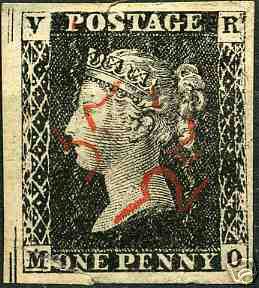
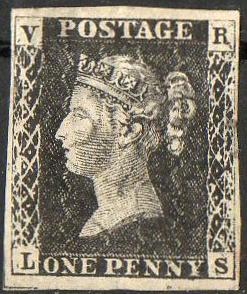

Forgeries of the 'VR' stamp, they have no dot behind 'PENNY'.
I've seen it with the bottom corner letters 'OA', 'MO' and 'LS'.
The face is quite 'white'. A similar forgery of the ordinary
stamp is shown as well (with corner letters JD).

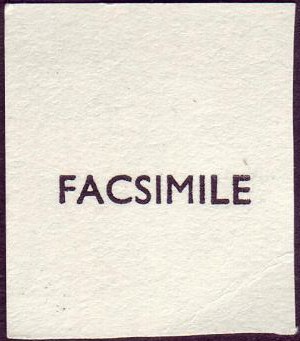
Another Facsimile made from a photograph, 'FACSIMILE' written on
the back of the stamp
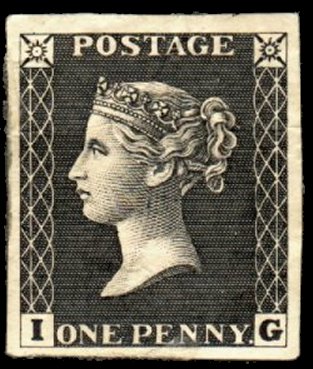
Other forgery with very large 'I G' in the corners, no dots in
the background and the side ornaments too perfectly done. I've
seen it with cancel.
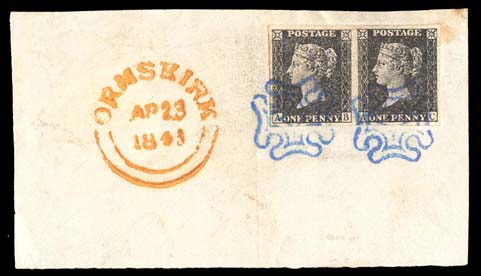
Forged envelope with orange 'ORMSKIRK AP23 1843' cancel and blue
Maltese cross cancels containing two penny-blacks
There exists at least three stamps with similar design with inscription 'LUNDY'; 'ONE PUFFIN' in black or brown and 'TWO PUFFINS' in blue, they were issued for the island of Lundy (bogus issues). The letters 'J' and 'A' are in the left and right lower corners respectively.
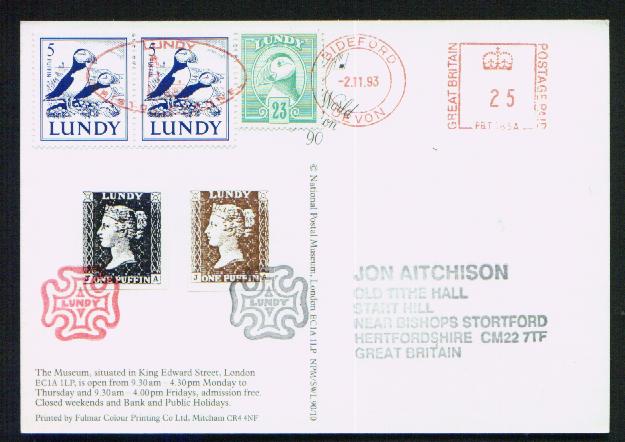
(Lundy bogus stamps)


(forgery of this stamp, using the next issue and colouring the
white lines blue,
zoom-out of top and bottom part)
I have seen a forgery of the 2 p blue stamp, made from the next issue (with white lines) by colouring the white lines blue, see pictures above.
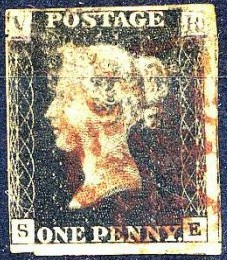
('VR' forgery, made from a genuine stamp by adding the letters
'V' and 'R'?)
It appears that it is possible to chemically alter the red color of the next 1 p issue to black.

(London Exhibition Sheet, 'reproduced by the collotype process
printed by Waterlow & Sons Limited')
In 1950 a souvenir sheet was issued in London for 'The London International Stamp Exhibtion'. On this souvenir sheet there is a 1 Sh Nova Scotia 1852 violet stamp, a Penny Black (corner letters GB) , a New South Wales 1 p red 1850, a Ceylon 4 p 1859 and a 4 p Cape triangle of 1853, it was reproduced by the collotype process and printed by Waterlow & Sons. I have seen all the cuts from this sheet offered as forgeries.
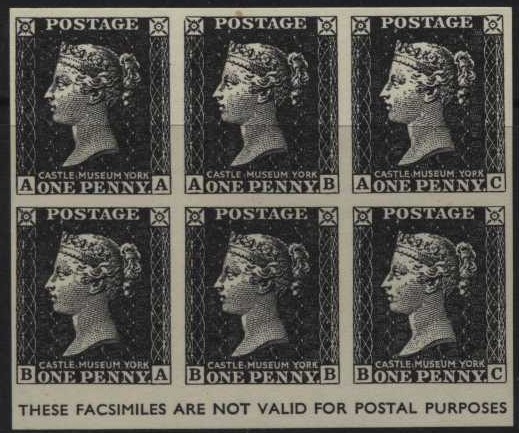
Facsimiles of the Castle Museum York, I've also seen one with a
red Maltese cross cancel on a piece of paper. Note the white dot
below the 'O' of 'POSTAGE'. I've also seen the words 'CASTLE
MUSEUM YORK' being blackened out, the resulting stamp pretending
to be a 'reprint'.
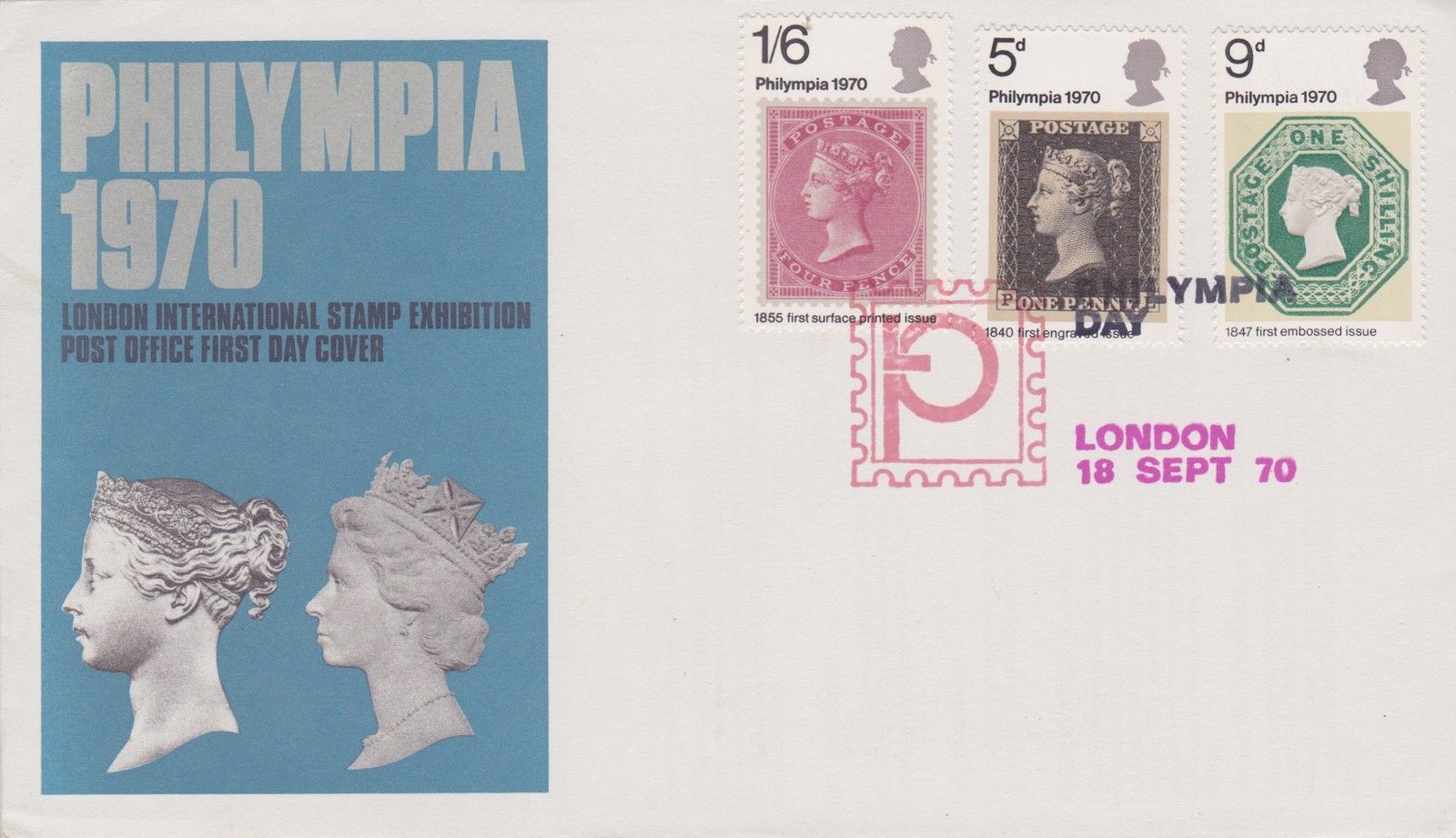
Philympia set of stamps of 1970 on cover.
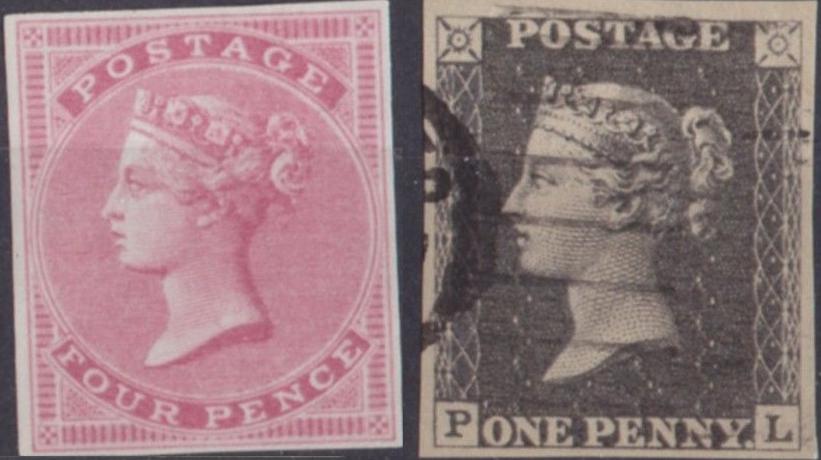
Cuts from 1970 Philympia stamps. Any uncancelled 1 p black stamps
with 'PL' corner letters (or with 'modern' cancels) most likely
come from these commemorative stamps.
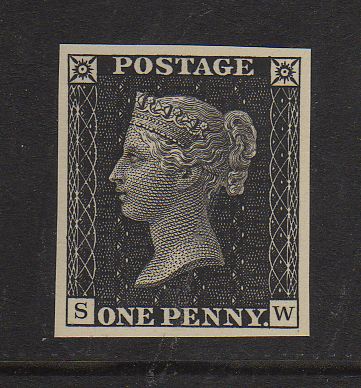
With corner letters 'SW' (impossible?). A reproduction from the
1980's.
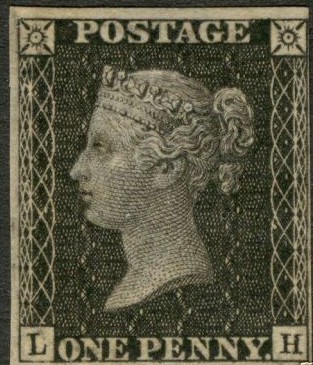
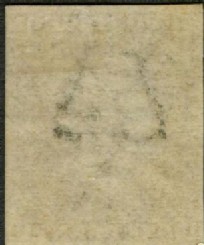
Royal reprint, with an inverted watermark
In 1864 a so-called 'Royal reprint' was made on paper with watermark 'Large Crown' (always inverted?). This was done by making prints of the plate nr 66 of the 1 p red. They were apparently ordered by members of the Royal family, but considerable confusion exists about this subject. It is not known how many reprints were actually made. More information can be found at: http://www.members.tripod.com/~pennyreds/royalreprint.html.
I've seen reprints of the 1 p black (General & VR issues) in unissued colours (green, orange, violet, red and brown). They are also known as 'Rainbow-reprints', due to the these many colours. Apparently these reprints were authorised by the Lord Mayor of London to raise funds for the British Red Cross during World War II. They were sold at Lancaster House London between 6th & 11th May 1940 (printed by Waterlow & Sons Ltd). All the reprints I have seen have the letter 'D' in the lower left corner and 'K' in the lower right corner:

(Reprints in fancy colours of the 'VR' issue and the normal
stamp)
By the way, I suspect that the above items are actually cut from a much larger 'reprint' stamp as shown below:
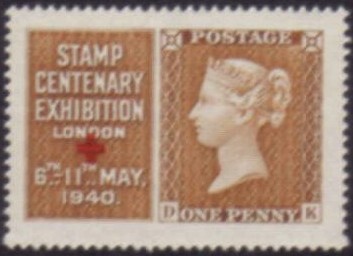
Perforated 'reprint' with attached label at the left, inscription
'STAMP CENTENARY EXHIBTION LONDON 6th - 11th MAY, 1940.'

A private reprint made for the Hamburg 1984 'Salon der Philatelie
zum XIX. Weltpostkongress', the inscription below the stamp is
'Reproduktion 1984'.
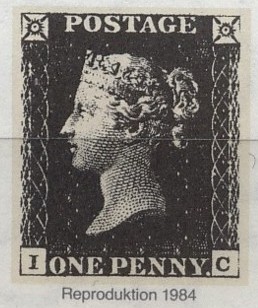
Zoom-in of this 'reproduction'
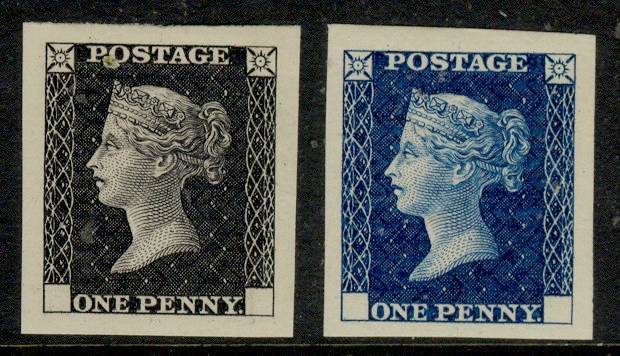
Two other 'reprints' of the 1 p black and 1 p blue, with no
letters in the bottom corners.
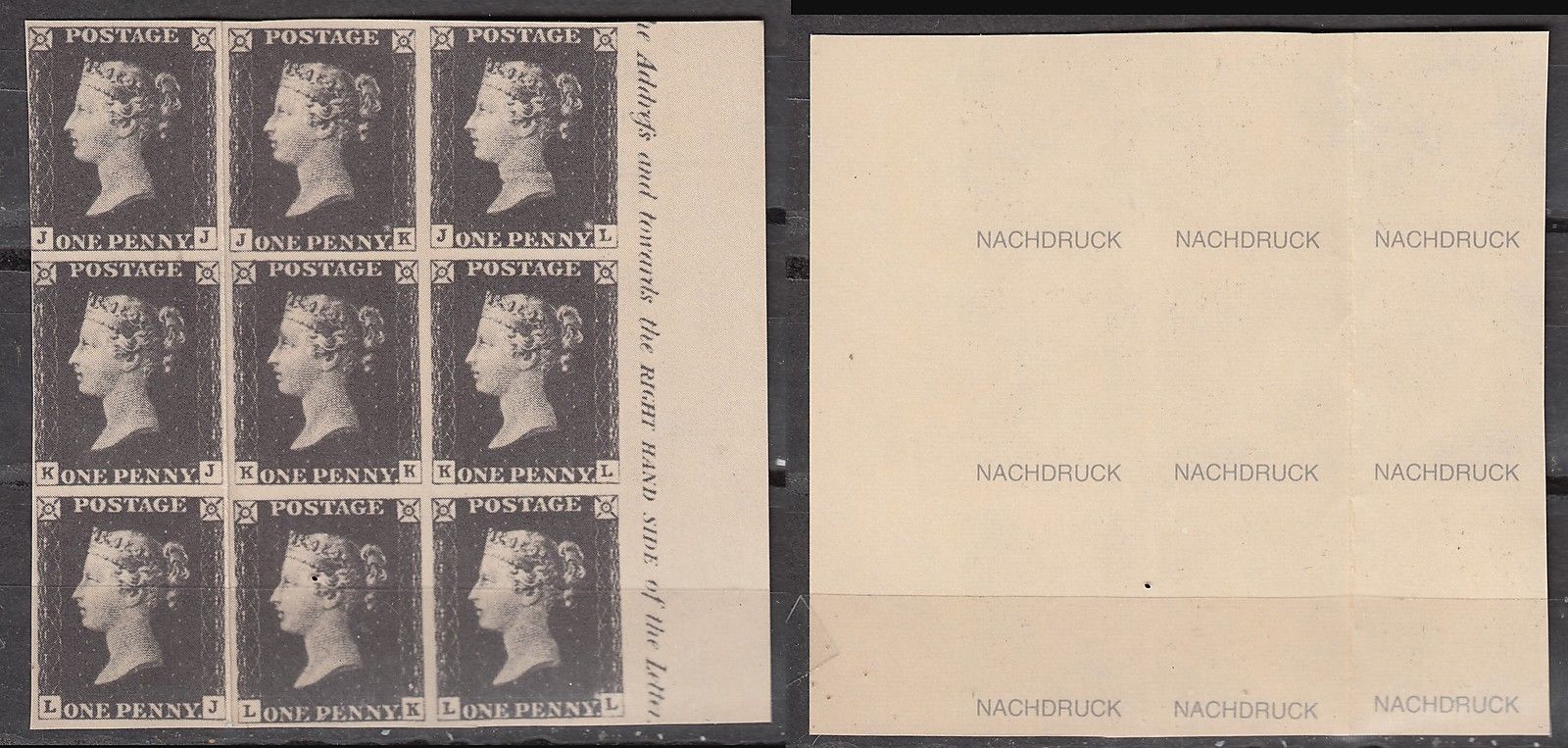
Some kind of modern photographic reproduction of a whole sheet
(here part of it) of German origins, with "NACHDRUCK"
printed at the back.
1 p brown 2 p blue (design changed slightly)
Black ink was used for the cancels of the 1 p black, but it was not satisfactory because inadequate cancels could not easily be detected. The ink for the cancellation was then changed to red, but could be readily removed with a solvent. Therefore, the stamp became red with a more fugitive ink, and the cancellation became black.
The 2 p now has two white lines below 'POSTAGE' and above'TWO PENCE'; shortly after the issue of the 2d stamp of 1840, it was noticed that the dark blue obscured the black cancel, therefore the stamp was lightened by placing the white lines.
The watermark on these stamps is 'Small Crown'. These stamps exist with a so-called 'ivory-head' the head is shining through on the back side of the stamp:
Value of the stamps |
|||
vc = very common c = common * = not so common ** = uncommon |
*** = very uncommon R = rare RR = very rare RRR = extremely rare |
||
| Value | Unused | Used | Remarks |
| 1 p | RR | * | |
| 2 p | RR | *** | |
1 Penny brown (red) 2 Pence blue
The watermark is 'Small Crown' or 'Large Crown' for this issue. Two different perforations exist: 14 and 16 (exist both with both watermarks).
Value of the stamps |
|||
vc = very common c = common * = not so common ** = uncommon |
*** = very uncommon R = rare RR = very rare RRR = extremely rare |
||
| Value | Unused | Used | Remarks |
Watermark 'Small Crown', perforated 16 |
|||
| 1 p | RR | * | |
| 2 p | RRR | *** | |
| Watermark 'Small Crown', perforated 14 | |||
| 1 p | RR | R | |
| 2 p | RRR | R | |
| Watermark 'Large Crown', perforated 16 | |||
| 1 p | RRR | R | |
| 2 p | RRR | RR | |
| Watermark 'Large Crown', perforated 14 | |||
| 1 p | ** | c | |
| 2 p | RRR | *** | |
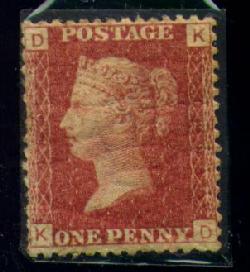
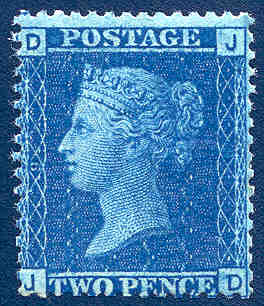

1 Penny brown 2 Pence blue
The watermark of this issue is 'Large Crown' (see picture above) and the perforation is 14. These stamps have plate numbers (although often very difficult to see due to cancels), the pictures below shows a stamp with plate number 225, it is hidden inside the left and right borders, the yellow arrows show the positions of the 2, 2 and 5 in the second image:
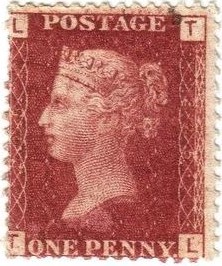
![]()

Plate '225'; see arrows in second image and plate '184' (zoom-in
of the right hand side of the stamp)
The plate numbers on the 1 p range from 71 to 225. Some platenumbers are rare, such as '77' and '225'. The plate numbers on the 2 p range from 7 to 15.
Value of the stamps |
|||
vc = very common c = common * = not so common ** = uncommon |
*** = very uncommon R = rare RR = very rare RRR = extremely rare |
||
| Value | Unused | Used | Remarks |
| 1 p | ** | c | |
| 2 p | R | c | |
The first Maltese cancels were done in red, but later black was also quite common. More uncommon colours as blue, violet, yellow, brown and orange also exist. Several types of these cancels exist.
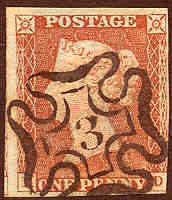
Maltese cross with number '3'
In London, some of these Maltese cancels exist with a numeral in the center (used from March 1843 to April 1844).
More on the Cancels of Great Britain can be found by clicking here.
http://www.members.tripod.com/~pennyreds/yz.html
Great Britain Line Engraved Victoria Made Easy by Wm F Blank: http://www.kernunnos.com/Philately/GBQVLE.html, explanation of all the types of these stamps (recommended!).